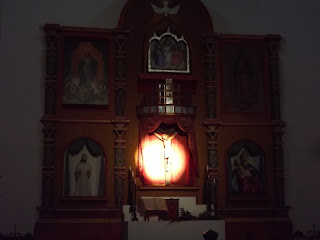The Franciscans who established the missions of Spanish Texas intended for the churches to be the center of mission life. It is only natural that they would want the most impressive and awe inspiring structures they could obtain with their often-limited funds. However, it was not the priests who built the churches. The design, and construction supervision was done by master builders or master masons (maestro de albañil). It seems to have been a rule that if an arch was needed, then a maestro de albañil was needed. Certainly, the priests had some input, and gave final approval to the plans. It is unfortunate that none of the Texas mission church plans have ever been found.
When Spain first arrived in North America, all of the masons had received their training in Europe. An individual would have to undergo an apprenticeship of about seven years with a master before he could be approved as a master mason. Eventually, there were masons who were trained in New Spain. Both European trained, and New Spain trained masons worked in Texas. Apprentices were schooled in math and science, and taught to use various instruments and charts. Using these, a mason was able to map the path of the sun, on any given day, at any location.
The maestro de albañil was then able to align the building, so that on a particular day, the sun would shine through a window casting a beam of light on a particular point inside the church. Today, this is what we call a solar illumination. The simplified drawing below shows the event.
The results are nothing less than spectacular. The following photographs taken at Mission Espiritu Santo, Goliad State Park and Historic Site, Goliad, Texas do not do justice to this phenomenon. It is something that should be seen in person. The photographs have not been altered in any way, and no artificial light was used. Photographs taken April 15, 2016. All times are Central Daylight Time.
 |
| Illumination window is in west wall in the choir loft |
 |
| Illumination window. |
 |
| At 6:46pm a circle of light can be seen at the lower left of Altar |
 |
| 6:50pm as the sun sets the light moves up and to the right |
 |
| 6:53pm |
 |
| 6:56pm |
 |
| 6:59pm |
 |
| 7:01pm |
 |
| 7:03pm |
 |
| 7:04pm |
 |
| 7:05pm |
Some illuminations occur on Catholic holy days or saints feast days, others on days of the equinoxes or solstices. At Mission San Juan Bautista in California, an illumination occurs on December 22, the winter solstice.
There are two problems with the illumination at Espiritu Santo and they are closely linked. The first concerns the date. The above photos show the illumination on April 15, however there is a photograph on file at Goliad State Park and Historic site that is labeled April 16, 2006 Easter Sunday.
 |
| Texas Parks & Wildlife photo labeled April 16, 2006 7:00pm Easter Sunday |
On close examination, the circle of light seems to be slightly off center. The fact is, there is not enough documentation to say with certainty, which is the correct date. Considering that this is a once a year event, and it requires the sun to be shining, it will take years to properly document. In 2015 there were heavy clouds on the 15th and 16th of April resulting in no photographs or data for that year. In 2016, the sky was clear on the 15th with excellent results, however on the 16th, it was cloudy and nothing was seen. The date must be ascertained to determine the significance of the illumination.
No solstice or equinox occurs in the month of April, and so those can be ruled out. Easter has no fixed date. The fact that the illumination happened on Easter April 16 in 2006, and will again in 2017, is probably coincidence. There are a number of saints who share April 15 as a feast day and several who share April 16. Those whose life times came after the construction of the mission should be ruled out. The church of Mission Espiritu Santo was dedicated in 1777. Of what remains two events stand out.
April 15 is the traditional Franciscan feast day of Gandolph of Binasco. He was a 13th century Franciscan priest who has been credited with miracles. Although the Pope did not beatify him until the 19th century, the Franciscans had acknowledged him with their own feast day. The Texas missionaries would have certainly known of him, and it is possible that some would have seen him as a role model.
April 16 is celebrated on the traditional Franciscan calendar as the anniversary of the profession of St. Francis.
The truth is we may never know the significance of the date. That should not detract from the amazing beauty of this phenomenon. The church is not active, so as can be seen in the 7:05pm photo, viewing is very informal. All that is needed is the price of admission to the state park, and of course a clear sky.
Copyright 2016
E. E. Barnes


No comments:
Post a Comment